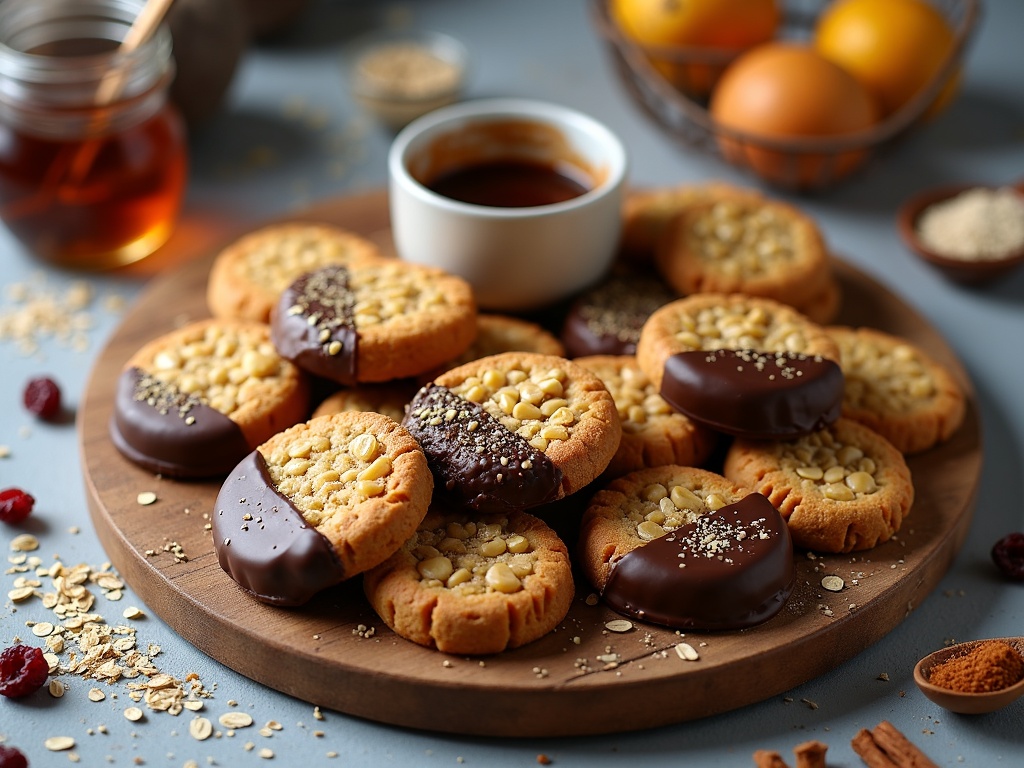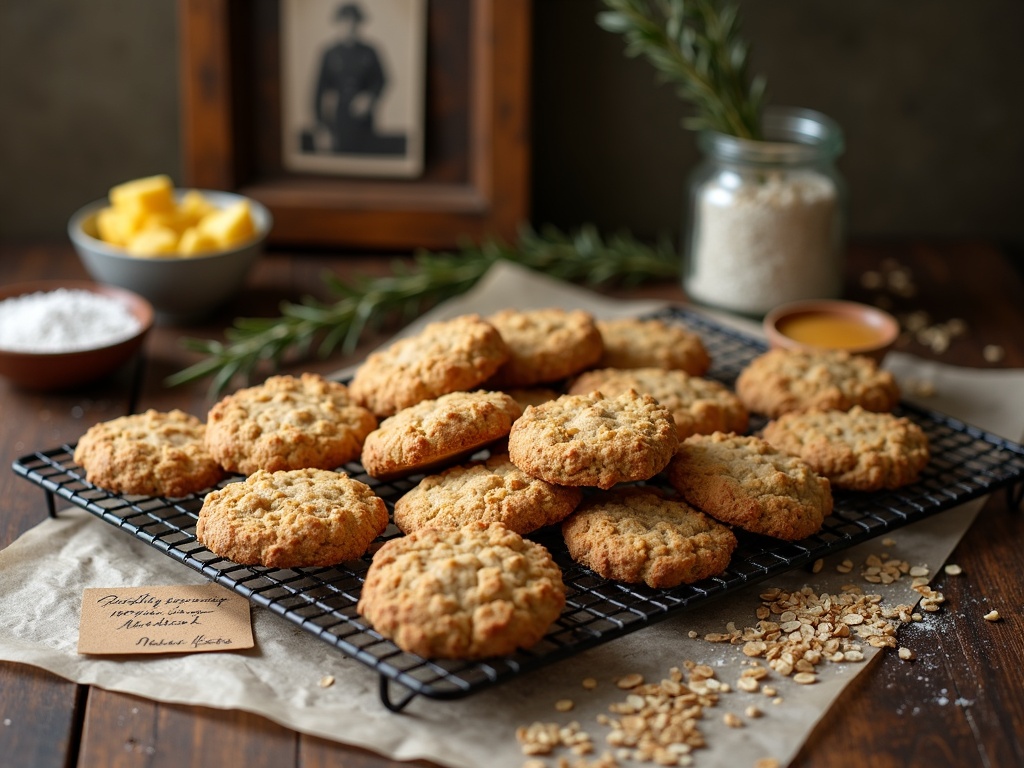Anzac Biscuits: A Taste of History
Anzac biscuits, with their rich history dating back to World War I, represent a significant piece of Australian and New Zealand culinary heritage born from wartime necessity.
Find In This Article
Key Takeaways
- Origin: Anzac biscuits originated during World War I as a nutritious, non-perishable food sent to soldiers serving in the Australian and New Zealand Army Corps.
- Simple Ingredients: The traditional recipe includes rolled oats, golden syrup, coconut, and flour, notably avoiding eggs to extend shelf life.
- Legal Protection: The name “Anzac” is protected under Australian law, with specific regulations governing what can be marketed as an Anzac biscuit.
- Texture: These biscuits offer a unique combination of crispy edges and a chewy center, contributing to their beloved status.
- Modern Variations: Though the classic recipe remains the standard, modern takes include chocolate-dipped versions, those enhanced with nuts, and even vegan alternatives.
For those interested in making their own Anzac biscuits, many classic and modern recipes can be found online, including those from trusted sources like the Australia.com culinary guide.
The Story Behind Australia’s Beloved Cookie
Anzac biscuits hold a special place in Australian food culture, with a history deeply connected to national identity and wartime solidarity. These delicious treats weren’t just created for taste — they played a practical role during one of history’s most difficult periods.
A Biscuit Born from Wartime Necessity
The story of Anzac biscuits begins during World War I, when concerned families wanted to send food to soldiers serving in the Australian and New Zealand Army Corps (ANZAC). These biscuits were the perfect solution to a real problem — how to send something nutritious that wouldn’t spoil during the long journey by sea to Europe and the Middle East.
The practical recipe used ingredients that were readily available during wartime:
- Golden syrup instead of eggs (which were scarce)
- Rolled oats for sustenance and energy
- Coconut for flavor and calories
- Flour and sugar to bind everything together
The name “Anzac” comes directly from the acronym for the Australian and New Zealand Army Corps troops who fought bravely at Gallipoli and other campaigns. These soldiers faced harsh conditions, and these sturdy homemade desserts provided both nourishment and a taste of home.
What makes Anzac biscuits truly unique is their protected status under Australian law. The term “Anzac” is regulated by the Department of Veterans’ Affairs, and strict guidelines exist about what can be called an Anzac biscuit. Any commercial use of the name must adhere to the traditional recipe — no chocolate chips, icing, or other modern additions allowed in anything labeled “Anzac.” This protection highlights how seriously Australians take this culinary heritage.
The original recipe has changed surprisingly little over the decades. While home bakers might experiment with slight variations (some prefer them chewy, others crisp), the core ingredients remain the same as those used by mothers, wives, and sisters sending care packages to distant battlefields.
Today, Anzac biscuits aren’t just eaten on Anzac Day (April 25th) but year-round as a sweet reminder of sacrifice and solidarity. Their simple ingredients and straightforward preparation have helped them remain popular in an age of fancy vegan cakes and elaborate desserts.
Each bite connects modern Australians to their history, making the humble Anzac biscuit much more than just a cookie — it’s a lasting symbol of resilience, resourcefulness, and remembrance.
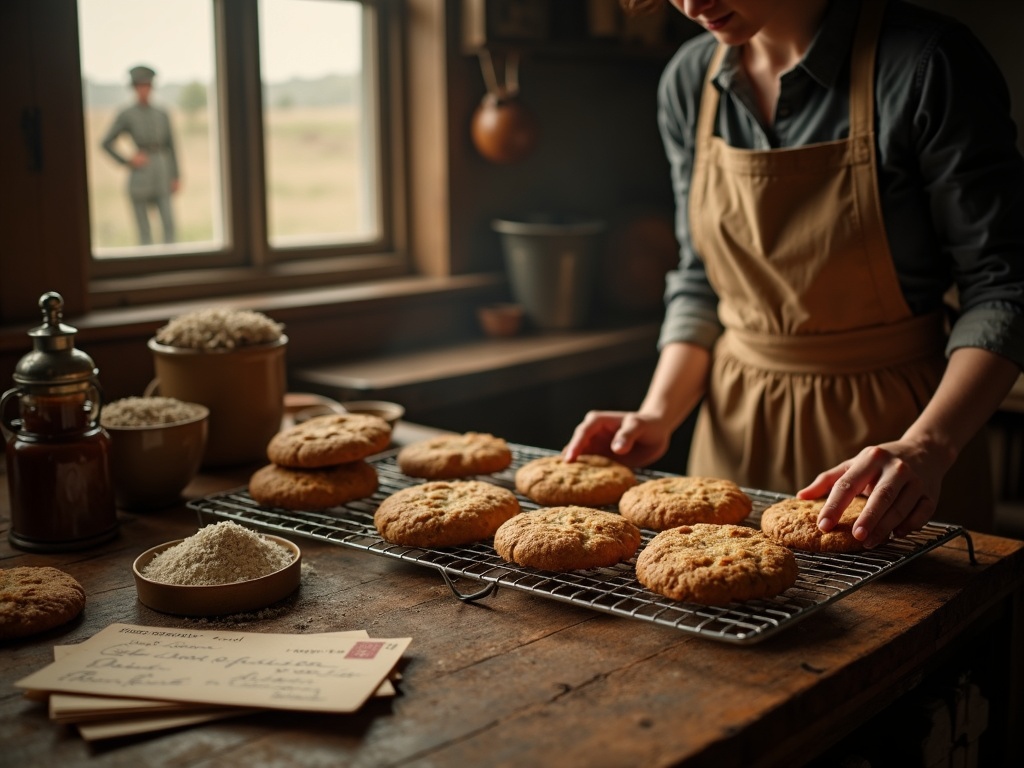
What Makes These Biscuits Special
Anzac biscuits stand out from other cookies with their distinctive flavor profile and unique texture. These traditional treats have captured hearts across generations, becoming more than just a tasty snack but a piece of cultural heritage. Their special qualities come from both their ingredients and preparation methods.
Distinctive Characteristics of Anzac Biscuits
Golden syrup gives Anzac biscuits their signature caramel-like flavor that’s instantly recognizable. This thick, amber-colored sweetener creates a depth of taste that regular sugar alone simply can’t match. I’ve found that this key ingredient creates that nostalgic flavor that makes these homemade desserts so memorable.
The texture of a perfect Anzac biscuit offers a delightful contrast – crispy around the edges while maintaining a chewy center. This dual-texture experience happens because of the unique combination of rolled oats, coconut, and the precise baking time. When made correctly, they provide that satisfying snap followed by a chewy bite that few other biscuits can replicate.
One of the most practical features of Anzac biscuits is their impressive shelf life. These treats can stay fresh for weeks when stored properly in an airtight container. This longevity comes from their low moisture content and the preservative qualities of golden syrup. Their staying power made them ideal for shipping to soldiers during wartime and now makes them perfect for preparing ahead for guests or holiday celebrations.
Traditional Anzac biscuits don’t contain eggs, which distinguishes them from most cookie recipes. This absence wasn’t merely a preference but a practical necessity during wartime when eggs were scarce. The binding power instead comes from the combination of melted butter and golden syrup. This egg-free formula not only contributes to their extended shelf life but also makes them suitable for those with egg allergies or following certain dietary restrictions.
The ingredient list remains refreshingly simple. Beyond the golden syrup, these biscuits typically include:
- Rolled oats for hearty texture and nutty flavor
- Desiccated coconut adding subtle sweetness and chew
- Plain flour providing structure
- Butter bringing richness
- Bicarbonate of soda creating the perfect rise
This straightforward combination creates a baked treat that’s greater than the sum of its parts. The magic happens when these basic ingredients combine and transform during baking.
The historic significance adds another layer to what makes these biscuits special. Their connection to World War I and the ANZAC soldiers gives them meaning beyond their taste. The recipe was designed to withstand long shipping journeys without refrigeration to troops overseas.
I’ve noticed that many modern variations exist, but purists insist on maintaining the traditional recipe. Some contemporary twists include adding:
- Nuts
- Chocolate chips
- Even a vegan adaptation using plant-based butter
While these variations can be delicious, the classic recipe delivers the authentic experience that has stood the test of time.
The simple preparation process adds to their charm. Even novice bakers can create perfect Anzac biscuits with minimal equipment and experience. This accessibility has helped keep the tradition alive through generations of home bakers looking to create easy homemade treats with cultural significance.
When baked to golden perfection, these humble biscuits deliver a taste experience that connects us to history while satisfying our sweet cravings with their unique combination of flavors and textures. Their special qualities have secured their place as an enduring favorite in recipe collections around the world.
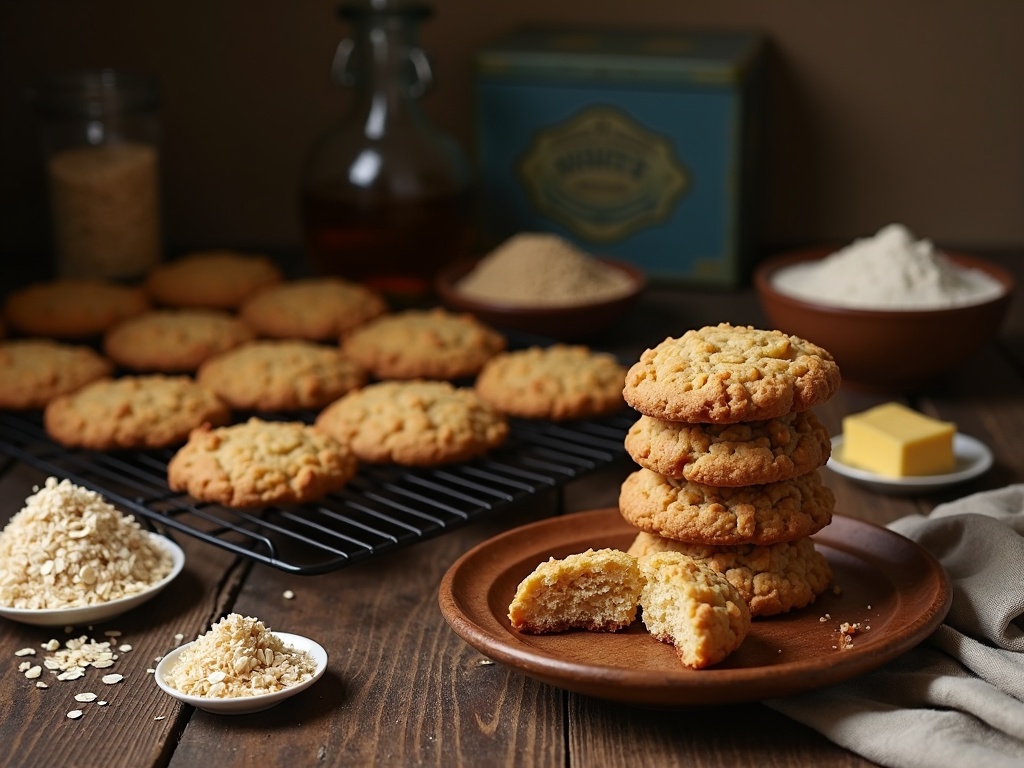
Ingredients You’ll Need
Anzac biscuits have a beautiful simplicity when it comes to their ingredient list. I’ve made these countless times, and their straightforward preparation is part of their charm. These iconic cookies require just a handful of pantry staples that combine to create that distinctive sweet, oaty flavor with a perfect chewy-yet-crisp texture.
The Dry Components
Rolled oats form the backbone of any authentic Anzac biscuit recipe. I always opt for traditional rolled oats rather than quick oats for their heartier texture and better shape retention during baking. Plain flour provides structure to the biscuits without adding any competing flavors, keeping the focus on the other distinctive ingredients.
Desiccated coconut adds that unmistakable tropical note and chewy texture that’s essential to the Anzac experience. Make sure you’re using unsweetened desiccated coconut rather than sweetened flaked coconut for the most authentic result.
Brown sugar is my preferred sweetener for these biscuits. Its molasses content brings depth and moisture that regular white sugar simply can’t match. The caramel notes perfectly complement the golden syrup in the recipe.
Here are the standard measurements I use for a batch of approximately 20–24 biscuits:
- 1 cup rolled oats
- 1 cup plain flour
- ⅔ cup desiccated coconut
- ¾ cup brown sugar
The Wet Ingredients & Raising Agent
Golden syrup gives Anzac biscuits their distinctive flavor and contributes to their lovely chewy texture. This thick, amber-colored sweetener is a key ingredient that can’t be easily substituted without changing the character of the biscuits.
Butter provides richness and helps create those crisp edges when the biscuits bake. I typically use unsalted butter to better control the overall salt content of the recipe.
The combination of baking soda and hot water creates the perfect leavening reaction when mixed with the golden syrup. This unique raising method helps give Anzac desserts their characteristic cracked tops and ideal texture – not too cakey, not too flat.
For the wet ingredients and raising agent, I typically use:
- ¼ cup golden syrup
- 125g butter (approximately ½ cup)
- ½ teaspoon baking soda
- 1 tablespoon hot water
I find this classic ingredient list produces consistently excellent results. While there are numerous variations out there (some add a touch of salt or vanilla, others substitute honey for golden syrup), the traditional recipe has stood the test of time for good reason.
One of the fascinating aspects of Anzac biscuits is how they compare to other traditional recipes in terms of ingredient simplicity. Unlike many modern quick bread recipes or holiday baking traditions, these biscuits contain no eggs, which was originally due to wartime rationing but now makes them naturally suitable for those with egg allergies.
For those following plant-based diets, Anzac biscuits are easily adaptable into a vegan-friendly treat by substituting the butter with a good quality vegan butter or coconut oil. The results remain delicious and maintain that perfect balance between chewy centers and crisp edges.
When gathering ingredients for your Anzac biscuits, quality matters. Fresh oats and coconut will give you the best flavor, while using genuine golden syrup rather than substitutes will ensure that authentic taste that makes these biscuits so beloved. Store ingredients properly to maintain freshness, especially the desiccated coconut which can go rancid if kept too long.
How to Make Perfect ANZAC Biscuits
Creating the perfect ANZAC biscuit is all about balance — achieving that ideal combination of chewiness and crispness that makes these historic treats so beloved. I’ve perfected my technique over years of baking these traditional Australian and New Zealand cookies, and I’m excited to share my method with you.
Step-by-Step Baking Process
I always start by preheating my oven to 180°C (350°F) to ensure it reaches the perfect temperature. The first real step is combining the dry ingredients in a large mixing bowl. I mix together rolled oats, plain flour, desiccated coconut, and brown sugar until evenly distributed. The brown sugar adds a delicious caramel undertone that complements the golden syrup perfectly.
Next comes the wet ingredient preparation. In a small saucepan over low heat, I gently melt the butter and golden syrup together, stirring occasionally until completely combined. This creates a wonderfully aromatic liquid that will bind all the ingredients together.
For the chemical reaction that gives ANZAC biscuits their distinctive texture, I dissolve the baking soda in hot water in a small cup or bowl. When added to the melted butter mixture, it creates a satisfying fizz — this is the reaction that helps create that perfect texture in the final delicious dessert.
The magic happens when I pour the butter mixture and dissolved baking soda into the dry ingredients. I fold everything together with a wooden spoon until thoroughly combined. The mixture should hold together when pressed between your fingers but still maintain some crumbliness.
Shaping the biscuits properly is crucial for even baking. I take tablespoons of mixture and roll them into balls, placing them on a lined baking tray with plenty of space between each one — they’ll spread considerably during baking. For a traditional finish, I flatten each ball slightly with a fork.
The final baking stage requires attention. I place the trays in the preheated oven and bake for 10–12 minutes until the biscuits turn a beautiful golden brown around the edges while remaining slightly softer in the center. This creates that perfect homemade cookie texture — crisp edges with a chewy middle.
Remember that ANZAC biscuits will continue to harden as they cool, so don’t be tempted to overbake them. Once removed from the oven, I let them rest on the baking tray for 5 minutes before transferring to a wire rack to cool completely.

Common Mistakes to Avoid
Baking the perfect Anzac biscuit requires attention to detail and an understanding of what makes these iconic treats special. I’ve seen many home bakers struggle with these classic cookies, often due to a few common pitfalls that can be easily avoided. Let me walk you through the most frequent mistakes and how to prevent them.
Ingredient and Preparation Errors
Using quick oats instead of rolled oats is perhaps the most frequent mistake I encounter. Quick oats absorb moisture differently and break down more easily during mixing, resulting in a texture that’s far from authentic. Traditional Anzac biscuits need the heartier texture and structure that only rolled oats provide. They maintain their shape better during baking and create that characteristic chewy-yet-crisp consistency that makes classic desserts like these so beloved.
Another critical error happens when substituting golden syrup. This distinctive sweetener gives Anzac biscuits their signature caramel notes and contributes to their unique chew. Honey, maple syrup, or corn syrup might seem like reasonable alternatives, but they alter both the flavor profile and texture significantly. The distinctive malty flavor of golden syrup is irreplaceable if you’re aiming for authentic results. I always recommend making the effort to find real golden syrup rather than settling for substitutes – it makes a remarkable difference in the final product.
Measuring ingredients incorrectly can also lead to disappointment. Unlike more forgiving quick bread recipes, Anzac biscuits require precision.
- Too much flour creates dry, crumbly cookies
- Too much golden syrup or butter results in biscuits that spread too thin
Getting your measurements right is key to achieving that perfect chewy center and crisp edge.
Baking Technique Issues
Overcrowding the baking tray ranks high on the list of technical mistakes. These biscuits need room to spread during baking – placing them too close together results in uneven cooking and biscuits that merge into one another. I’ve found that limiting each standard baking sheet to 12 biscuits maximum gives optimal results. This allows proper air circulation and even heat distribution, ensuring consistent browning across all your holiday treats.
Overbaking the biscuits is possibly the easiest way to ruin a batch. Anzac biscuits continue to firm up as they cool, so they should be removed from the oven when they still appear slightly underdone in the center. The edges should be just turning golden while the centers remain somewhat soft.
- Bake until the edges are light golden brown
- Let them cool on the tray for 5 minutes
- Transfer to a wire rack for complete cooling
This method helps you achieve that ideal combination of crisp edges with chewy centers that makes homemade recipes so satisfying.
The temperature of your ingredients matters more than you might think. Using melted butter that’s too hot when combined with golden syrup and baking soda can deactivate the leavening agent before it has a chance to work in the oven. I always allow the melted butter mixture to cool slightly before proceeding with the recipe.
Finally, not allowing baking trays to cool between batches can result in uneven cookies. When you place cookie dough on a hot tray, it starts spreading before it even reaches the oven, leading to thinner, often overdone biscuits. For consistent results across all your baked goods, I either rotate between multiple trays or allow used trays to cool completely before reusing them.
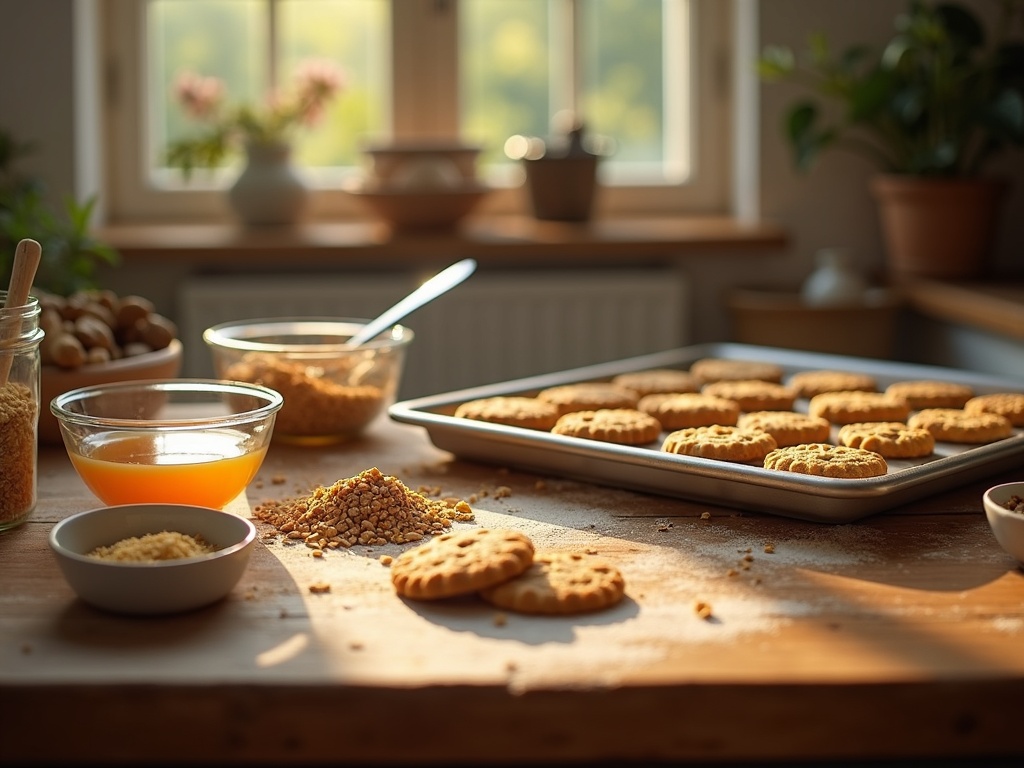
Tips for the Best Results
Achieving perfect Anzac biscuits requires attention to a few key details that can make all the difference between good and great results. These traditional Australian and New Zealand treats deserve proper handling to honor their heritage while ensuring they turn out delicious every time.
Preparation and Baking Techniques
Using room temperature ingredients creates a more cohesive dough that’s easier to work with. I’ve found that butter at room temperature incorporates much better with the golden syrup and dry ingredients, resulting in a smoother texture throughout the biscuit. Taking your butter out of the refrigerator about 30 minutes before baking makes a noticeable difference in how well everything mixes together.
When placing your Anzac biscuits on the baking sheet, allow adequate space between each one. These biscuits spread significantly during baking, and without proper spacing, you’ll end up with one giant cookie rather than individual treats. I recommend leaving at least 2 inches between each ball of dough on your baking sheet. This spacing allows for even heat circulation and proper spreading, ensuring each delicious homemade dessert bakes to perfection.
The cooling process is just as important as the baking itself. Here are some essential cooling tips to follow:
- Allow biscuits to rest on the baking sheet for 5 minutes after removing from the oven
- Transfer to a wire rack to cool completely before handling
- Resist the temptation to taste test while hot (though difficult!)
- Ensure they’re room temperature before storing to prevent moisture buildup
Proper cooling ensures your Anzac biscuits develop their characteristic chewy texture or crisp snap, depending on how you prefer them. Moving them too early can cause breakage, while inadequate cooling before storage leads to soggy results.
Storage solutions make a significant difference in maintaining freshness. Once your biscuits have cooled completely, transfer them to an airtight container immediately. This step is crucial as Anzac biscuits can quickly absorb moisture from the air, compromising their texture. If you’re planning to keep them for more than a few days, consider adding a piece of parchment paper between layers to prevent sticking.
For the longest shelf life, store your container in a cool, dry place away from direct sunlight. Properly stored Anzac biscuits can maintain their quality for up to two weeks, though they rarely last that long in most households! If you’ve made a particularly large batch, consider freezing some for later enjoyment – they freeze beautifully and can be thawed at room temperature whenever a sweet treat craving strikes.
The choice of baking sheet can also impact your results. I prefer using light-colored, non-stick baking sheets rather than dark ones, as they provide more even heating and reduce the chance of burning the bottoms of these sugar and golden syrup-rich biscuits.
For special occasions, consider making smaller biscuits by using just a teaspoon of dough rather than a tablespoon. These mini versions cook faster and make charming additions to holiday dessert platters or afternoon tea settings.
By following these straightforward but important tips, your Anzac biscuits will turn out consistently excellent, with that perfect balance of chewiness and crunch that makes them such a beloved classic recipe across generations.
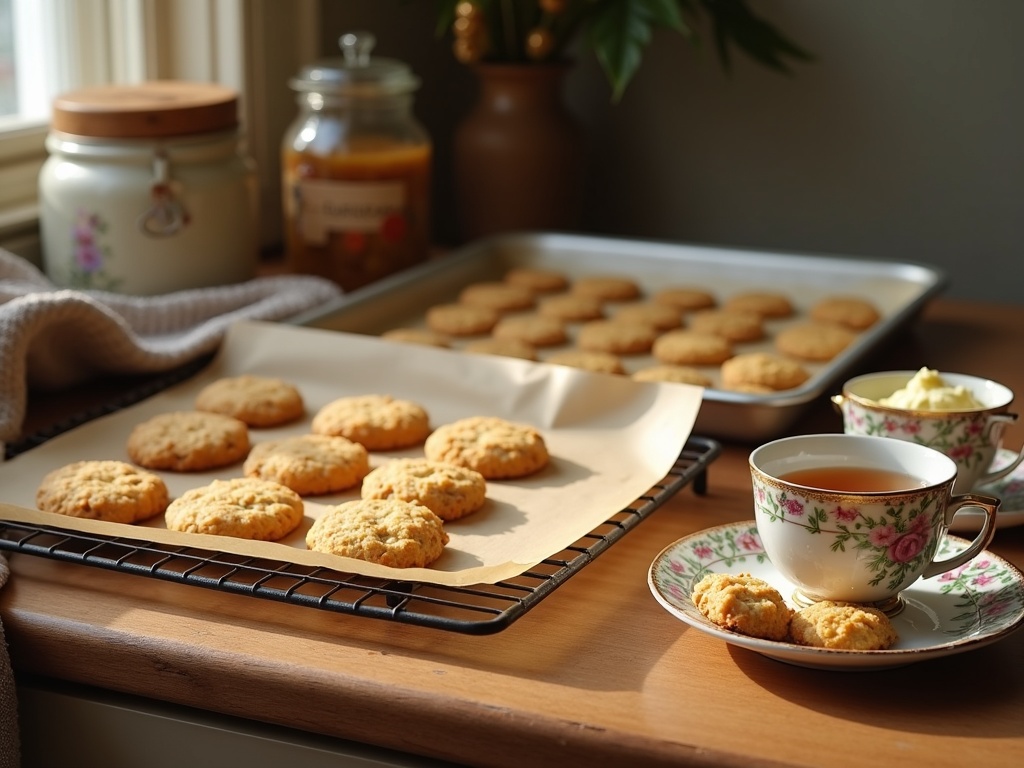
Storage and Shelf Life
Proper storage of Anzac biscuits is key to maintaining their delicious flavor and texture. I’ve found that taking a few simple steps can extend their shelf life considerably, allowing you to enjoy these classic treats for longer.
Keeping Biscuits Fresh
An airtight container is essential for storing Anzac biscuits properly. Once your biscuits have completely cooled after baking, transfer them into a clean, dry container with a tight-fitting lid. This simple step prevents moisture and air from affecting the texture of your biscuits, keeping them crisp on the outside and chewy in the middle.
These traditional biscuits maintain their freshness for up to two weeks when stored correctly at room temperature. I’ve noticed they stay at their best quality when kept in a cool, dark place like a pantry or cupboard rather than near a heat source or in direct sunlight.
For the absolute best flavor and texture experience, try to consume your homemade Anzac desserts within the first week after baking. The initial days offer that perfect balance between freshness and the full development of flavors as the ingredients meld together.
Long-Term Storage Options
If you’ve made a large batch or want to prepare these treats in advance, freezing provides an excellent option for longer storage. Here’s how I recommend freezing Anzac biscuits:
- Place cooled biscuits in a single layer on a baking sheet and freeze for 1–2 hours
- Transfer the frozen biscuits to freezer bags or containers
- Label with the date and contents
- Store in the freezer for up to 3 months
When you’re ready to enjoy your frozen Anzac biscuits, simply remove them from the freezer and let them thaw at room temperature for about 30 minutes. For that fresh-baked taste and texture, you can also warm them briefly in a low oven.
If you’re planning to make these biscuits for special occasions like holiday celebrations, preparing and freezing them ahead of time can be a real time-saver. The texture might change slightly after freezing, but the distinctive oat and golden syrup flavors remain intact.
Modern Variations
The classic Anzac biscuit has stood the test of time, but that doesn’t mean it can’t evolve with our changing tastes and dietary needs. I’ve found that modern twists on this traditional recipe can breathe new life into an old favorite while still respecting its heritage. These adaptations have made this iconic treat accessible to more people and introduced exciting new flavor combinations.
Creative Flavor Enhancements
One of the most popular modern takes on Anzac biscuits is the chocolate-dipped version. This simple enhancement adds a touch of indulgence to the honey-sweet original. I typically dip half the biscuit in melted dark chocolate for a striking visual contrast and balanced flavor profile. The slight bitterness of good quality dark chocolate perfectly complements the sweetness of the golden syrup in the traditional recipe. For an even more decadent treat, try exploring dessert variations that incorporate white or milk chocolate drizzles as well.
Adding nuts or seeds to Anzac biscuits brings welcome texture and nutritional benefits. Popular additions include:
- Chopped macadamias for a buttery, Australian native flavor
- Sunflower seeds for a subtle nuttiness and added crunch
- Chia seeds for omega-3 fatty acids without altering the classic taste
- Crushed walnuts for earthy depth and contrast
These add-ins not only enhance the texture but also introduce healthy fats and proteins, making the biscuits slightly more nutritious while maintaining their comforting character. When adding nuts, I find toasting them briefly before incorporation intensifies their flavor contribution to the final biscuit.
For those with specific dietary requirements, the Anzac biscuit has proven remarkably adaptable. Gluten-free versions substitute traditional oats (which may contain trace gluten) with certified gluten-free oats and replace regular flour with gluten-free alternatives. Rice flour or a commercial gluten-free blend can work well, though you might need to adjust the liquid ratios slightly for optimal texture. Baking enthusiasts often report that adding a small amount of xanthan gum helps replicate the binding properties lost when removing traditional flour.
Vegan adaptations have also become increasingly popular. The traditional recipe already lacks eggs, making it simpler to veganize than many other baked goods. The main substitutions involve:
- Plant-based butter or coconut oil instead of dairy butter
- Maple syrup or agave nectar in place of honey
- Ensuring your sugar is vegan-friendly (some are processed with bone char)
The results can be just as chewy and satisfying as the original version. Vegan baking techniques have evolved significantly, making these substitutions nearly undetectable in the final product.
Some modern bakers have even developed reduced-sugar versions by cutting back on the golden syrup and sugar, sometimes incorporating natural sweeteners like mashed banana or applesauce. While purists might raise an eyebrow, these adaptations have made the classic treat accessible to those monitoring their sugar intake.
Flavor innovations continue to emerge, with additions like dried cranberries, orange zest, or even tangy fruits finding their way into contemporary recipes. During the festive season, some bakers incorporate warm spices like cinnamon and nutmeg, creating holiday-inspired versions of this classic biscuit.
While respecting the traditional recipe is important, these modern variations have helped Anzac biscuits remain relevant and loved by new generations of bakers and eaters. The basic formula provides a fantastic canvas for creativity while still honoring the biscuit’s storied past.
